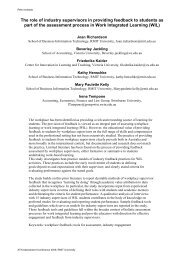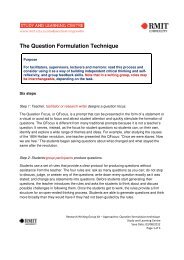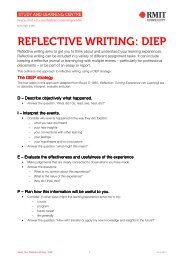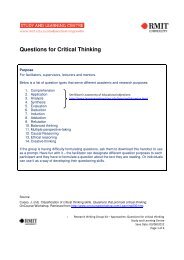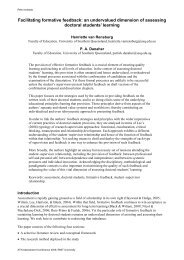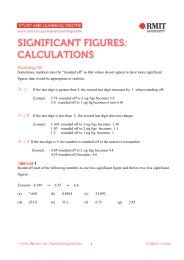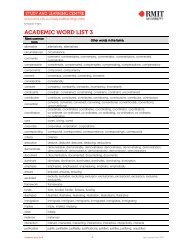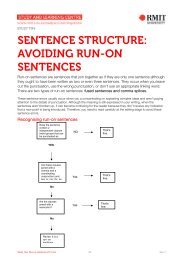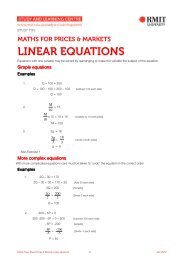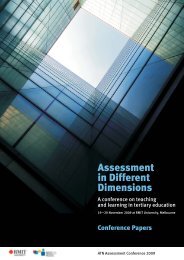student feedback and leadership - Office for Learning and Teaching
student feedback and leadership - Office for Learning and Teaching
student feedback and leadership - Office for Learning and Teaching
Create successful ePaper yourself
Turn your PDF publications into a flip-book with our unique Google optimized e-Paper software.
Part A: Developing a Distributed Leadership Model - Secton 4: Outcomes <strong>and</strong> Critical Sucess Factors<br />
IV.<br />
Multi-level approaches to <strong>leadership</strong> in curricula improvement strategies<br />
<strong>for</strong> assessment of learning practices, teaching large classes <strong>and</strong> teaching<br />
capabilities were identified in the ART Case Studies. However in so doing<br />
it was also recognised that single point-in-time improvements in <strong>student</strong><br />
<strong>feedback</strong> are not sufficient <strong>and</strong> there is need <strong>for</strong> a process of benchmarking<br />
over time that will enable longer-term trends. This led the<br />
DVC(A) to establish a special project in which staff from the School<br />
of Mathematics <strong>and</strong> Geospatial Sciences undertook a statistical study<br />
to identify the key indicators of teaching quality. This study found that<br />
good teaching is the primary factor <strong>for</strong> 6 out of the 9 subject areas in the<br />
College of Business, 3 out of 12 subject areas in the College of Design<br />
<strong>and</strong> Social Context, <strong>and</strong> 13 out of 25 subject areas in the College of<br />
Science, Engineering <strong>and</strong> Technology. There was also a strong correlation<br />
between GTS <strong>and</strong> overall course satisfaction scores at a university level,<br />
among the three Colleges, <strong>and</strong> <strong>for</strong> most subject areas 4 .<br />
The study confirmed the findings of the ARTs in terms of the key indicators<br />
of <strong>student</strong> satisfaction. For the College of Business the top five indicators were<br />
(in order of importance) Good <strong>Teaching</strong>; course enjoyment, organisation of the<br />
course, the provision of good course materials, facilities (environment). For the<br />
College of Design <strong>and</strong> Social Context the top five indicators were (in order<br />
of importance) course enjoyment, Good <strong>Teaching</strong>, organisation of the course,<br />
the provision of good course materials <strong>and</strong> facilities (environment). For the<br />
College of Science, Engineering <strong>and</strong> Technology the top five indicators were<br />
(in order of importance) Good <strong>Teaching</strong>, organisation of the course, course<br />
enjoyment, the provision of good course materials <strong>and</strong> facilities (environment).<br />
In addition to the quantitative study, a qualitative study identified commonalities<br />
in positive <strong>student</strong> responses to teachers that are enthusiastic, engage the<br />
<strong>student</strong>s, actively listen to <strong>student</strong> needs, implement changes <strong>for</strong> <strong>student</strong>s,<br />
establish clear structure <strong>and</strong> objectives in courses, clearly communicate<br />
<strong>feedback</strong> <strong>and</strong> are motivated by CES results.<br />
While a direct causal link between the action taken to improve <strong>student</strong><br />
<strong>feedback</strong> by the three ARTs cannot be proved, both the School of Economics,<br />
Finance <strong>and</strong> Marketing <strong>and</strong> the School of Mathematics <strong>and</strong> Geospatial<br />
Sciences recorded an increase in the Overall Student Satisfaction Rate<br />
of around 7% between 2007 <strong>and</strong> 2008 (from 60% to 67.1% <strong>and</strong> from 69%<br />
to 76.4% respectively), although the School of Property <strong>and</strong> Construction<br />
recorded a slight decrease in overall <strong>student</strong> satisfaction over the same period.<br />
Over the same period all Schools recorded an increase in the Good <strong>Teaching</strong><br />
Score (GTS) of between 1-10%.<br />
4 Bed<strong>for</strong>d, A; Romagnano, S; Da Costa, C; Bed<strong>for</strong>d, M.(2007) ‘CES Per<strong>for</strong>mance Analysis:<br />
Quantitative <strong>and</strong> Qualitative Investigation of CES Data: What Drives Good <strong>Teaching</strong>, RMIT School of<br />
Mathematical & Geospatial Sciences<br />
Page 73



